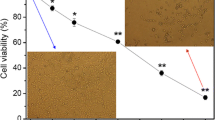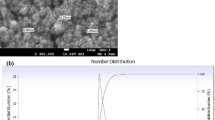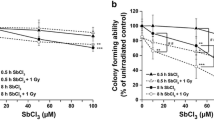Abstract
As one of the typical actinide elements, the chemical and radioactive toxicities of uranium have attracted more attention. In this work, the toxicity mechanism of uranium-238 in HK-2 cells was studied in detail using in vitro approach. The results confirmed that exposure to uranium solution significantly reduced the viability of HK-2 cells. Flow cytometry and double fluorescence AO/PI staining suggested that apoptosis was the main cause of the death of HK-2 cells. Moreover, reactive oxygen species and mitochondrial membrane potential tests further demonstrated that HK-2 cells underwent apoptosis under the combined action of oxidative stress and mitochondrial damage. The tails in the comet assay and the abnormal nuclear morphology in DAPI staining confirmed the genotoxicity of uranium to HK-2 cells. In conclusion, uranium mainly causes apoptosis and genotoxicity after exposure, and the main mechanisms of apoptosis are mainly related to oxidative stress, mitochondrial damage, and DNA damage.







Similar content being viewed by others
References
Asic A, Kurtovic-Kozaric A, Besic L, Mehinovic L, Hasic A, Kozaric M, Hukic M, Marjanovic D (2017) Chemical toxicity and radioactivity of depleted uranium: the evidence from in vivo and in vitro studies. Environ Res 156:665–673
Gritsaenko T, Pierrefite-Carle V, Lorivel T, Breuil V, Carle GF, Santucci-Darmanin S (2017) Natural uranium impairs the differentiation and the resorbing function of osteoclasts. Biochim Biophys Acta Gen Subj 1861(4):715–726
Joseph SJ, Arunachalam KD, Murthy PB, Ramalingam R, Musthafa MS (2021) Uranium induces genomic instability and slows cell cycle progression in human lymphocytes in acute toxicity study. Toxicol In Vitro 73:105149
Ma M, Wang R, Xu L, Xu M, Liu S (2020) Emerging health risks and underlying toxicological mechanisms of uranium contamination: lessons from the past two decades. Environ Int 145:106107
UNSCEAR (United Nations Scientific Committee on the Effects of Atomic Radiation). (2016) Sources, effects and risks of ionizing radiation. Annex D: biological effects of selected internal emitters-uranium. Report. UNSCEAR, United Nations, New York (NY). https://www.unscear.org/unscear/uploads/documents/publications/UNSCEAR_2016_Annex-D-CORR.pdf. Accessed 2016
Periyakaruppan A, Kumar F, Sarkar S, Sharma CS, Ramesh GT (2007) Uranium induces oxidative stress in lung epithelial cells. Arch Toxicol 81:389–395
Domingo JL, Llobet JM, Tomas JM, Corbella J (1987) Acute toxicity of uranium in rats and mice. Bull Environ Contam Toxicol 39:168–174
Carrière M, Avoscan L, Collins R, Carrot F, Khodja H, Ansoborlo E, Gouget B (2004) Influence of uranium speciation on normal rat kidney (NRK-52E) proximal cell cytotoxicity. Chem Res Toxicol 17:446–452
Zhang XF, Ding CL, Liu H, Liu LH, Zhao CQ (2011) Protective effects of ion-imprinted chitooligosaccharides as uranium-specific chelating agents against the cytotoxicity of depleted uranium in human kidney cells. Toxicology 286:75–84
Wade-Gueye NM, Delissen O, Gourmelon P, Aigueperse J, Dublineau I, Souidi M (2012) Chronic exposure to natural uranium via drinking water affects bone in growing rats. Biochim Biophys Acta 1820:1121–1127
Hao Y, Ren J, Liu C, Li H, Liu J, Yang Z, Li R, Su Y (2014) Zinc protects human kidney cells from depleted uranium-induced apoptosis. Basic Clin Pharmacol Toxicol 114:271–280
Yu L, Li W, Chu J, Chen C, Li X, Tang W, Xia B, Xiong Z (2021) Uranium inhibits mammalian mitochondrial cytochrome c oxidase and ATP synthase. Environ Pollut 271:116377
Keith LS, Faroon OM (2022) Chapter 36-Uranium∗∗The findings and conclusions in this chapter are those of the authors and do not necessarily represent the views of the Agency for Toxic Substances and Disease Registry. In: Handbook on the toxicology of metals (5th edn). Academic Press, pp 885–936
Venditti P, Di Stefano L, Di Meo S (2013) Mitochondrial metabolism of reactive oxygen species. Mitochondrion 13:71–82
Zuo L, Zhou T, Pannell BK, Ziegler AC, Best TM (2015) Biological and physiological role of reactive oxygen species-the good, the bad and the ugly. Acta Physiol (Oxf) 214:329–348
Yi J, Yuan Y, Zheng J, Hu N (2018) Hydrogen sulfide alleviates uranium-induced kidney cell apoptosis mediated by ER stress via 20S proteasome involving in Akt/GSK-3β/Fyn-Nrf2 signaling. Free Radic Res 52:1020–1029
Yazzie M, Gamble SL, Civitello ER, Stearns DM (2003) Uranyl acetate causes DNA single strand breaks in vitro in the presence of ascorbate (vitamin C). Chem Res Toxicol 16:524–530
Coryell VH, Stearns DM (2006) Molecular analysis of hprt mutations generated in Chinese hamster ovary EM9 cells by uranyl acetate, by hydrogen peroxide, and spontaneously. Mol Carcinog 45:60–72
El-Garawani I, Allam HK, Shehata YA, Fadel K, El Kattan A (2021) Genotoxicity linked to occupational exposure in uranium mine workers: granzyme B and apoptotic changes. Environ Sci Pollut Res Int 28(27):36793–36802
WHO (World Health Organization) (2004) Uranium in drinking-water. Background document for development of WHO guidelines for drinking-water quality. https://www.who.int/docs/default-source/wash-documents/wash-chemicals/uranium-background-document.pdf. Accessed 2004
Wilkins RC, Kutzner BC, Truong M, Sanchez-Dardon J, McLean JR (2002) Analysis of radiation-induced apoptosis in human lymphocytes: flow cytometry using Annexin V and propidium iodide versus the neutral comet assay. Cytometry 48:14–19
Nowak A, Zakłos-Szyda M, Żyżelewicz D, Koszucka A, Motyl I (2020) Acrylamide decreases cell viability, and provides oxidative stress, DNA damage, and apoptosis in human colon adenocarcinoma cell line Caco-2. Molecules 25:368
Zheng J, Zhao T, Yuan Y, Hu N, Tang X (2015) Hydrogen sulfide (H2S) attenuates uranium-induced acute nephrotoxicity through oxidative stress and inflammatory response via Nrf2-NF-κB pathways. Chem Biol Interact 242:353–362
Lu Y, Liu Y, Yang C (2017) Evaluating in vitro DNA damage using comet assay. J Vis Exp 128:56450
Cheng X, Chu J, Zhang L, Suo Z, Tang W (2022) Intracellular and extracellular untargeted metabolomics reveal the effect of acute uranium exposure in HK-2 cells. Toxicology 473:153196
Shaki F, Hosseini MJ, Ghazi-Khansari M, Pourahmad J (2012) Toxicity of depleted uranium on isolated rat kidney mitochondria. Biochim Biophys Acta 1820:1940–1950
Bao Y, Wang D, Li Z, Hu Y, Xu A, Wang Q, Shao C, Chen H (2013) Efficacy of a novel chelator BPCBG for removing uranium and protecting against uranium-induced renal cell damage in rats and HK-2 cells. Toxicol Appl Pharmacol 269:17–24
Acknowledgements
Financial support was obtained from the National Natural Science Foundation of China (22276084 and 21906073), the “Youth Innovation Promotion Association of the Chinese Academy of Sciences”, and the Fundamental Research Funds for the Central Universities (lzujbky-2022-32)
Author information
Authors and Affiliations
Corresponding author
Ethics declarations
Conflict of interest
The authors declare no competing financial interest.
Additional information
Publisher's Note
Springer Nature remains neutral with regard to jurisdictional claims in published maps and institutional affiliations.
Rights and permissions
Springer Nature or its licensor (e.g. a society or other partner) holds exclusive rights to this article under a publishing agreement with the author(s) or other rightsholder(s); author self-archiving of the accepted manuscript version of this article is solely governed by the terms of such publishing agreement and applicable law.
About this article
Cite this article
Qiang, S., Guo, K., Zhang, D. et al. The damage mechanism of uranium(VI) to HK-2 cells. J Radioanal Nucl Chem 332, 1277–1285 (2023). https://doi.org/10.1007/s10967-023-08843-2
Received:
Accepted:
Published:
Issue Date:
DOI: https://doi.org/10.1007/s10967-023-08843-2




